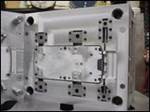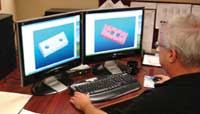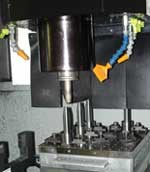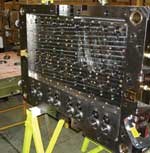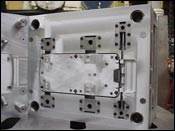Faster Turns and Higher Accuracy with CAM
The right CAM software package investment paid for itself in less than a year and contributed to one mold builder’s ability to produce complex molds quickly and accurately.
Dynamic Tool & Design (Menomonee Falls, WI) is a full-service, mold builder providing assistance in product design, in-house mold design, mold flow analysis, certification of steel and heat treating, and verification of critical mold dimensions, typically +/-.0002 in. Most of the customer products the molds are used to produce are snap-shut closures, the caps on bottled consumer products from shampoo to ketchup and mustard. Each year, the company creates about 85 new molds, and provides duplicates of many more plus mold rebuilds.
“Dynamic does two-shot and complex, large multi-cavity work, which are the tools staying in the U.S.,” says Randy Lee Meissner, CNC Department Supervisor. “We create mold designs and manufacturing processes based directly on customer part data. The trend is coming back to the U.S. a bit, partly because the accuracy, working speed of the tool and delivery on these molds is better. Today, we are delivering the tool in half the time it took just a few years ago. But everybody wants full service: part design, mold flow, mold production and documentation, inspection of first articles,” continues Meissner.
Looking for ways to improve the productivity of programming and reduce machining cycle times, and potentially eliminate secondary operations, Dynamic within the last year looked into CAM software from Delcam (Salt Lake City, UT), a developer of CAM software worldwide. It had seven years invested in a previous software system, but it was just not allowing Dynamic to accomplish its goals of faster turns and higher accuracy.
According to Meissner, the previous software was hard to use and not flexible in its applicability. “It was horrible for putting path on. We were cutting a lot of air, surface finish was not good enough and it was a fight to get it to run five-axis programs or to post the programs. So we decided it was time to check into something better, with a shorter learning curve.” He called Programming Plus, a local Delcam reseller.
Programming Plus recommended Delcam’s PowerMILL for high-speed machining, PowerSHAPE for building molds and Electrode for shaping the many graphite electrodes Dynamic uses to shape mold cavities.
Dynamic liked that PowerMILL includes a wide range of five-axis strategies for both roughing and finishing, three-axis swarf machining and parametric surface finishing, together with faster calculation times, improved point distribution and easier data management. All of which contribute to Dynamic’s ability to produce complex molds quickly and accurately.
Rough Machining
The range of five-axis roughing strategies includes machining to or from a point, orientation through a line or curve and programming using a reference surface. Using five-axis roughing reduces the number of setups needed to machine many components. It can also be used to give a more efficient cutting angle that will allow more material to be removed with each pass.
Using a spiral toolpath for roughing allows the overall machining time for mold components to be reduced by minimizing the number of air moves. In addition, a more consistent load can be applied to the cutter, limiting wear and reducing the chance for tool damage.
Another available roughing strategy allows Dynamic take full advantage of cutter designs that can cut with the side of the tool and so take deeper cuts. Called raceline machining, the roughing passes are progressively smoothed out as the toolpaths move further from the main form. The resulting paths minimize sudden changes in direction and so allow faster machining, with less wear on the cutter and lower stress on the machine tool.
For all roughing strategies, PowerMILL orders toolpaths so that air moves are further reduced. This also makes the ordering of rest roughing toolpaths more efficient. And that’s big with Dynamic programmers. The rest toolpaths completely remove material left by a previous larger tool allowing only areas that require smaller cutters to be re-machined, greatly reducing milling times.
“Rest machining is a huge time saver,” Meissner says. “This alone has easily saved us upward of 25 to 50 percent on our cavity machining cycle times, cutting down roughing times, particularly, so we can move quickly to the finished mold. With Delcam PowerMILL, the tool is always in the cut, removing the unwanted material, with no air cutting. You’re always on the steel with Delcam.”
And the leads and links feature allows the crew at Dynamic customize tool ramp in and ramp out, which is important when cutting 65 Rc steel. It means they can prevent shock and tool breakage and help the machine tool remain productive.
Finish Machining
PowerMILL also gives Dynamics’ programmers strategies for finish machining, including parametric offset machining, three-axis swarf machining and interleaved constant Z.
In parametric offset machining, the number of toolpaths used over a surface of varying width is kept constant. Instead of stopping and starting some paths, the step-over between the toolpaths is varied within preset limits. This approach gives a better finish by avoiding sudden changes of direction that can leave marks on the surface—exactly what Dynamic must avoid on every mold.
Three-axis swarf machining is used to finish vertical walls with the side of the tool, resulting in a smoother surface finish than cutting the wall in a series of operations at different Z levels.
After the first few processes were created with Delcam PowerMILL, the programmers instantly saw the benefits. “The software almost makes the job fun,” according to Meissner’s crew. “The product’s good but the guys make it work.”
A Dynamic programmer adds, “As an example, by allowing Visual Basic to interface with PowerMILL we can automate many of the machining processes we use on a daily basis. This means that where we are using 10 tools and know we need to apply them all to create a mold, the software will automatically create path that will result in a correctly machined part using the same strategies we used on similar parts.”
The consistency that Delcam helps Dynamic maintain in its programming directly and positively affects time in process and customer satisfaction. “We develop processes where each engineer is using the same techniques, the same tools, so there is no variation among the work the guys are doing,” Meissner explains. “That way the customer also can count on consistency in the molds we do from order to order. In the old days, there may have been some hand-fitting. No more.”
Meissner adds, “The graphical icons and representation of the toolpaths in Delcam are terrific because they help us think of different strategies. Another helpful tool for the programmers is that template creation allows us to easily process multiple toolpaths on similar part configurations unattended, saving time in programming and assuring consistency.”
And when the programmers want to edit paths, they can do it quickly. They can pick any part of a toolpath, delete it and still have the rest of the toolpath intact. “That’s a big timesaver for us,” Meissner says. “With the other software, when we wanted to make any change in the program it had to re-crunch everything, which could be five to 10 minutes, depending on the size of the file, despite having two processors. This directly impacted our service to customers.”
Integrated CAM Suite
Upstream from PowerMILL in the programming department is Delcam PowerSHAPE. With PowerSHAPE Dynamic analyzes the solid models for damaged, duplicated or missing surfaces, inspects draft angles, and programmers can visualize hard-to-mold regions—such as thin walls and ribs and undercut areas. They can also repair, replace or modify surface or solid models and add textures, logos and complex embossed reliefs.
PowerSHAPE also provides alternative methods the programmer can select for constructing a surface from a given set of lines, arcs or points to get the result that is best for a given design. And with Smart Surfacing, the choice of method is made automatically by the software to give the best possible surface. If the programmer wants to see other options, he can scroll through the alternative solutions. The software’s selection is updated automatically as data is added to the design.
Dynamic also uses Delcam Electrode, which is fully integrated within PowerSHAPE and PowerMILL. Possibly the most sophisticated electrode software around, Electrode provides automatic generation of solid electrode models with optional toolpath generation for EDM. Within a few minutes a complex cavity in a model can be automatically extracted to form a collision-checked, 3-D solid model of the electrode together with its holder, setup sheets and toolpaths.
The Latest Equipment
Dynamic was one of the first moldmakers in the country to use a CNC toolchanger and traveling wire EDM with auto threading capabilities, allowing it to run its equipment unattended. It hasn’t looked back, and continues to invest in the technology it takes to remain competitive in a very demanding market.
Machining centers in the busy 55-person shop include two robot-loaded Bostomatic carbon cutters, four OKK vertical machining centers, a Makino V33 VMC and a Mikron UCP710 five-axis high-speed machining center. “High-speed hard cutting allows us to cut cores and cavities in hardened steel while holding very tight tolerances,” Meissner notes. The hard-cutting process, in many cases, eliminates extensive polishing, reducing leadtimes.
Providing programs for the five-axis machines is not difficult. “Programming five-axis (actually 2+3) with PowerMILL is simple, and that is from one of the guys who just started programming. The crew at Dynamic plans to increase their use of it, beginning with more training,” Meissner explains.
A new high-speed Makino carbon cutting machine was being installed that will help the company more quickly machine the graphite for the sinker EDM and it will improve machining accuracy 0.0002 in. over the machine it replaces. Another edge for Dynamic.
“One of our latest innovations is the use of robotics in the manufacturing process. The robotic systems run 24 hours a day, 7 days a week, completely unattended,” Meissner says. “So, even when the lights go out, projects are still in production and even in programming. With Visual Basic the company can program lights out. We are big on lights-out machining, but we are also interested in lights-out programming,” Randy points out.
Dynamic runs a full complement of Mitsubishi CNC EDM sinker machines with toolchangers that run around the clock unattended. The robotic systems linked to these machines change electrodes and workpieces automatically.
The Bottom Line
“Every aspect of building a mold is broken down into hours for path, machining, grinding, assembly—every step in the process,” Meissner explains. “And we trace it so we know exactly where our time is being spent. And we know how much time the Delcam suite has saved us in programming and machining.”
The investment in Delcam will have paid for itself in much less than a year at Dynamic—just in time eliminated from the machining cycle and programming time. At Dynamic it’s all about time—quality molds delivered to customers on time, literally to the minute, and Delcam is giving Dynamic that winning edge over global competition.
Related Content
Making Quick and Easy Kaizen Work for Your Shop
Within each person is unlimited creative potential to improve shop operations.
Read MoreThe Role of Social Media in Manufacturing
Charles Daniels CFO of Wepco Plastics shares insights on the role of social media in manufacturing, how to improve the “business” side of a small mold shop and continually developing culture.
Read MoreConfronting the Mold Design Talent Drought
Recently, I reposted on LinkedIn the results of an informal survey we conducted, which revealed a shortage of skilled mold designers. It quickly gained a lot of traction. Given the response, I thought I'd summarize the feedback and keep the conversation going.
Read MoreHow to Use Scientific Maintenance for More Accurate Mold and Part Troubleshooting
Discover how adopting scientific maintenance approaches helps improve mold lifespan, minimize failures, and optimize production outcomes.
Read MoreRead Next
New Design Strategy for Generating Hybrid Aluminum Tooling
Design, machining and analysis software aids in aluminum mold manufacture.
Read MoreAre You a Moldmaker Considering 3D Printing? Consider the 3D Printing Workshop at NPE2024
Presentations will cover 3D printing for mold tooling, material innovation, product development, bridge production and full-scale, high-volume additive manufacturing.
Read MoreReasons to Use Fiber Lasers for Mold Cleaning
Fiber lasers offer a simplicity, speed, control and portability, minimizing mold cleaning risks.
Read More
